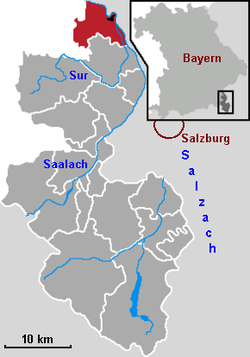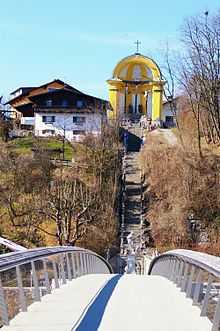Laufen, Germany
| Laufen | ||
|---|---|---|
| ||
 Laufen | ||
Location of Laufen within Berchtesgadener Land district  | ||
| Coordinates: 47°56′N 12°56′E / 47.933°N 12.933°ECoordinates: 47°56′N 12°56′E / 47.933°N 12.933°E | ||
| Country | Germany | |
| State | Bavaria | |
| Admin. region | Oberbayern | |
| District | Berchtesgadener Land | |
| Subdivisions | 74 Gemeindeteile | |
| Government | ||
| • Mayor | Ludwig Herzog | |
| Area | ||
| • Total | 35.31 km2 (13.63 sq mi) | |
| Elevation | 394-412 m (−958 ft) | |
| Population (2012-12-31)[1] | ||
| • Total | 6,869 | |
| • Density | 190/km2 (500/sq mi) | |
| Time zone | CET/CEST (UTC+1/+2) | |
| Postal codes | 83410 | |
| Dialling codes | 08682 | |
| Vehicle registration | BGL (until 1972 LF) | |
| Website | www.stadtlaufen.de | |
- For the Swiss municipality, see Laufen, Basel-Country.
Laufen is a municipality on the southeastern border of Bavaria with Austria.
History


It was first mentioned in a deed of 748. The rapids that gave the town the name (Laufen = rapid running waters) were also responsible for the town's wealth from the salt trade. Small boats that transported the extremely valuable cargo from the rapids north of Salzburg were reloaded at Laufen to larger boats by privilege of the Prince-Archbishop of Salzburg. When the independent principality was finally divided in 1816 between the Bavarian kingdom and the Habsburg Empire in the wake of the Napoleonic Wars, the town was split into a Bavarian part carrying the name of Laufen and into an Austrian town (the former Laufen suburbs on the right hand side of the river) by the name of Oberndorf. With the building of railways by the middle of the 19th century the transport of salt on the river Salzach came to an end, taking away the former source of wealth. A number of floods devastated both towns by the end of the century. The flood of 1899 destroyed the old bridge. A new iron bridge was built in a safer place up the river and opened jointly by the King of Bavaria and the Austrian Emperor in 1903.
Laufen Castle is a square-shaped 15th-century castle that was built for the Archbishop of Salzburg. It overlooks the Salzach river. During World War II the castle was used first as a prisoner-of-war camp for officers, Oflag VII-C. Then In May 1942 the officers were transferred to another camp, and the castle was used as an internment camp Ilag VII housing some hundreds of men deported from the Channel Islands of Jersey and Guernsey and some American civilians that had been caught in Europe by the declaration of war by Germany on the United States on 11 December 1941. (See Ilag#Ilag VII Laufen and Tittmoning.)
International relations
Laufen, Germany is twinned with:
 Laufen, Switzerland
Laufen, Switzerland
See also
Footnotes
- ↑ "Fortschreibung des Bevölkerungsstandes". Bayerisches Landesamt für Statistik und Datenverarbeitung (in German). 31 December 2012.
References
| |||||||
